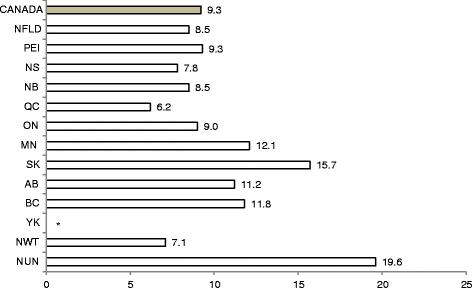Predictors of a negative labour and birth experience based on a national survey of Canadian women
- PMID: 27193995
- PMCID: PMC4870779
- DOI: 10.1186/s12884-016-0903-2
Predictors of a negative labour and birth experience based on a national survey of Canadian women
Abstract
Background: A negative birth experience has been shown to have a significant impact on the well-being and future choices of mothers. The objective of this study was to assess the prevalence of, and identify the risk factors associated with a negative birth experience for women in Canada.
Methods: The study was based on secondary data analysis of the Maternity Experiences Survey (MES), a Canadian population database administered to 6,421 Canadian women in 2006. The examined outcome - negative birth experience - was derived from mothers' self-report of overall labour and birth experience. Independent variables were maternal demographics, health characteristics, pregnancy-related characteristics, and birth characteristics. Multivariable logistic regression analysis was performed to determine the significant predictors of negative birth experience. Adjusted Odds Ratios (AOR) and 95 % Confidence Intervals (CI) are reported.
Results: Negative birth experience was reported among 9.3 % of women. The main significant predictors of a negative birth experience included older age (AOR 2.29, 95 % CI, 1.03-5.07), violence experienced in the past two years (AOR, 1.62, 95 % CI, 1.21-2.18), poor self-perceived health (adjusted OR, 1.95, 95 % CI, 1.36-2.80), prenatal classes attended (adjusted OR, 1.36, 95 % CI, 1.06-1.76), unintended pregnancy (adjusted OR, 1.30, 95 % CI, 1.03-1.63), caesarean birth (AOR, 1.65, 95 % CI, 1.32-2.06), and neonate admission to intensive care (AOR, 1.40, 95 % CI, 1.08-1.82).
Conclusion: Significant predictors of a negative labour and birth experience were identified through this study, a first in the Canadian context. These findings suggest future research directions and provide a basis for the design and evaluation of maternal health policy and prevention programs.
Keywords: Birth; Canada; Labour; Maternity experiences survey.
Figures
References
Publication types
MeSH terms
Grants and funding
LinkOut - more resources
Full Text Sources
Other Literature Sources
Medical
Miscellaneous


